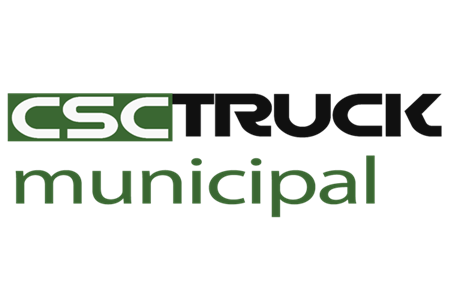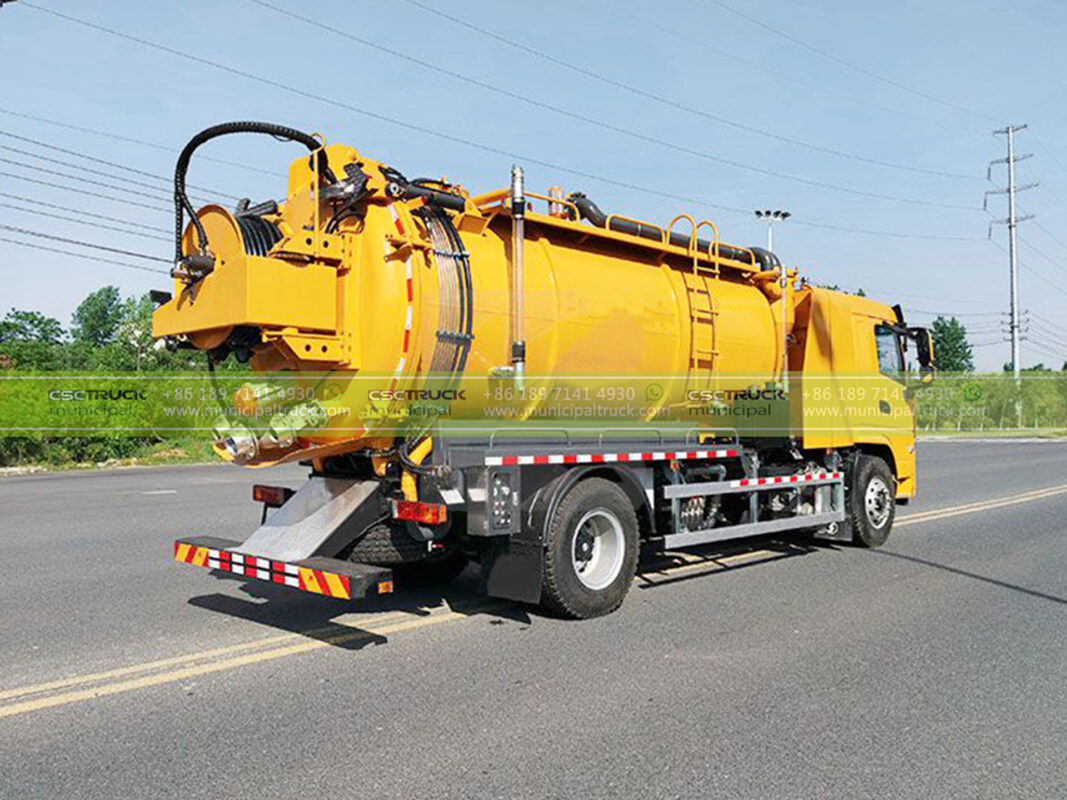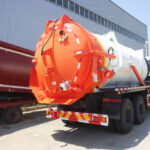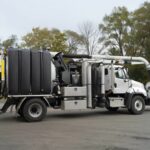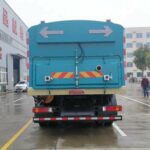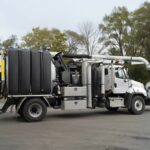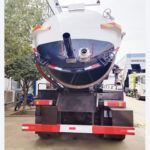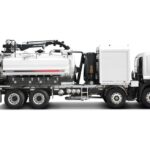Beneath the Surface – The Critical Need for Advanced Sewer Cleaning
Maintaining the vast, hidden networks of sewer pipelines beneath our cities and towns is a relentless challenge fundamental to public health, environmental protection, and urban functionality. Decades of service, coupled with constant assault from grease, roots, sediment, and structural wear, lead to reduced flow capacity, persistent blockages, and potential catastrophic failures. Traditional cleaning methods often involve sequential steps using disparate equipment – perhaps mechanical rodding followed by a separate vacuum truck – leading to inefficiencies, extended project timelines, potential recontamination of cleaned sections, and increased disruption. Enter the combo sewer jetter truck, a technological marvel engineered specifically to overcome these limitations. This integrated powerhouse combines high-pressure water jetting and powerful vacuum extraction onto a single, highly mobile chassis, creating a synergistic relationship that revolutionizes pipeline cleaning and rehabilitation preparation. This overview delves into the intricate mechanics and profound operational advantages of this vacuum-jetting synergy, underscoring why it has become an indispensable asset for modern infrastructure management.
Deconstructing the Powerhouse – Core Systems Explained
Understanding the synergy requires first appreciating the individual capabilities seamlessly integrated within the combo sewer jetter truck:
- The Jetting System: Hydrodynamic Force Unleashed
- At its heart lies a high-pressure pump, often generating forces ranging from 1,500 PSI for general cleaning to over 4,000 PSI for tackling root intrusion or hardened deposits. This pump pressurizes water sourced from an onboard potable water tank (typically 1,500 to 4,000+ gallons) or a connected hydrant.
- Pressurized water travels through reinforced, flexible hoses – sometimes hundreds or even thousands of feet long – to specialized nozzles at the hose terminus. These nozzles (forward-cutting for blockages, down-cutting for settled debris, spinner jets for walls, root saws) are engineered to transform pressure into velocity, creating intense hydrodynamic jets that scour, fracture, cut, and dislodge obstructions and pipe wall build-up. The focused energy strips away grease, silt, sand, mineral scale, and severs penetrating roots, effectively restoring the pipe’s hydraulic profile and preparing surfaces for further action.
- The Vacuum System: Engineered Debris Evacuation
- Simultaneously operational, the vacuum system employs a high-capacity exhauster or positive displacement blower (PD blower), driven by the truck’s power take-off (PTO) or a dedicated auxiliary engine. This creates powerful negative air pressure (vacuum).
- A large-diameter suction hose, deployed into the access point (manhole, cleanout), utilizes this vacuum to draw in the dislodged debris, contaminated water, and flushing liquid generated by the jetting process. This mixture is transported at high velocity into a robust debris body or tank.
- Inside the tank, advanced separation technology – often involving baffles, screens, and sometimes cyclonic action – separates solids and liquids. Liquids might be recirculated for jetting in closed-loop systems (after filtration) or held for responsible disposal.
The Synergy Effect – Where 1+1>2 in Pipeline Cleaning
The true genius of the combo sewer jetter truck lies not merely in housing two systems, but in their operational symbiosis. This synergy manifests in transformative ways:
- Continuous Operation, Eliminating Staging Delays: Unlike sequential methods, jetting and vacuuming occur concurrently or in rapid, coordinated alternation. As debris is fractured and flushed by the jetter, the vacuum immediately extracts it from the immediate vicinity. There’s no waiting for a separate vac truck to arrive, eliminating downtime and preventing dislodged material from settling back onto the pipe invert or being pushed downstream to create secondary blockages.
- Optimized Cleaning Efficiency: The immediate removal of debris by the vacuum prevents the scouring water from becoming overly laden with solids, which can drastically reduce its cleaning effectiveness. Cleaner water maintains higher nozzle velocity and impact force. Furthermore, operators can tailor jetting pressure, nozzle type, and vacuum power in real-time based on observed conditions within the pipe, achieving a level of precision and effectiveness impossible with separated systems.
- Enhanced Debris Management and Environmental Control: The integrated vacuum system provides immediate containment of wastewater and hazardous materials (grease, pathogens, chemicals). This drastically reduces the risk of spills onto streets or into storm drains during the cleaning process. Liquids and solids are captured directly at the source.
- The Foundation for Rehabilitation: This synergy is particularly critical for pipe rehabilitation preparation. Methods like Cured-In-Place Pipe (CIPP) lining demand an exceptionally clean, sound host pipe wall. The combo truck’s ability to aggressively scour surfaces while simultaneously evacuating all loosened material and contaminated rinse water ensures the pipe is meticulously prepared in a single pass. Residual debris, which can compromise liner adhesion or point repair seals, is effectively eliminated by the concurrent vacuum action.
Applications Unleashed – Tackling Complex Challenges
The vacuum-jetting synergy equips the combo sewer jetter truck to excel in scenarios where traditional methods struggle:
- Severe Root Removal: Dense root masses blocking pipes are cut by specialized root saw nozzles under high pressure. Critically, the severed roots and trapped sediment within the root ball are immediately vacuumed out, preventing downstream clogs and significantly delaying regrowth compared to cutting alone.
- Fatberg and Impacted Grease Elimination: Accumulations of Fats, Oils, and Grease (FOG), especially hardened into fatbergs, require high-pressure (often hot water) jetting to liquefy and break apart. The concurrent vacuum is essential to rapidly evacuate this liquefied mess before it cools and re-solidifies elsewhere in the system. Leaving it behind simply moves the problem.
- Heavy Sediment and Grit Removal: Pipes suffering from chronic low flow or located in sandy areas accumulate significant sand, grit, and silt. Jetting fluidizes these deposits, but without immediate vacuum extraction, they merely shift downstream. The combo truck lifts the entire slurry out of the pipe, restoring capacity and preventing downstream sedimentation issues.
- Precise Pre-Rehabilitation Cleaning: As emphasized, achieving the “white pipe” standard for CIPP lining or a perfectly clean surface for point repairs (like robotic patch installations or grout seals) is a core strength. The combined action removes all loose scale, biofilm remnants, and debris particles that could interfere with bonding.
- Post-Repair Cleanout: After lining or point repairs, residual installation materials (resin, felt fibers, grout, lubricants) need removal. The combo truck efficiently jets and vacuums this debris, ensuring the rehabilitated pipe achieves its full design flow capacity immediately.
Operational Imperatives – Maximizing Synergy in the Field
Leveraging the full potential of vacuum-jetting synergy demands careful consideration:
- Personnel Expertise: Operators must be highly skilled in both jetting and vacuum principles. This includes understanding safe hose handling under pressure, selecting optimal nozzles and pressures for specific obstructions, managing hose advancement/retraction synchronized with vacuum loading, recognizing signs of system overload (e.g., vacuum loss indicating a full tank or clog), and adhering to stringent confined space entry protocols. Continuous training is paramount.
- System Matching and Capacity: The jetting pump’s pressure/flow output, the vacuum system’s airflow (CFM) and water lift capability, hose diameters (jetting and vacuum), and debris tank capacity must be appropriately matched. A powerful jetter paired with an undersized vacuum system creates a bottleneck, negating the synergy. Tank capacity dictates operational run time before offloading is required.
- Water Management Strategy: Utilizing onboard water offers mobility but limits run time. Connecting to a hydrant provides continuous supply but reduces mobility. Closed-loop recirculation systems, where filtered wastewater from the debris tank is reused for jetting, dramatically extend operational reach and conserve water, but require careful monitoring of water quality and filtration performance to prevent pump or nozzle damage from re-circulated solids. Disposal regulations for collected solids and non-recirculated liquids must be strictly followed.
Environmental and Economic Advantages – The Synergy Dividend
The integrated approach delivers significant tangible benefits beyond operational efficiency:
- Reduced Environmental Impact: Immediate vacuum capture of wastewater and solids drastically minimizes the risk of spills and contamination of surrounding soil or waterways. Closed-loop water recycling significantly reduces freshwater consumption. By enabling effective trenchless cleaning and rehabilitation preparation, combo trucks support methods that avoid the massive environmental disruption (habitat fragmentation, soil erosion, noise, dust) and resource consumption associated with traditional open-cut excavation and replacement.
- Enhanced Operational Economy: Combining jetting and vacuuming onto one chassis eliminates the cost of mobilizing, fueling, and operating multiple pieces of equipment. Reduced project time (due to eliminating staging delays between jetting and vacuuming) translates directly into lower labor costs and less traffic disruption. The ability to thoroughly clean pipes in-situ extends their usable lifespan, deferring the enormous capital expense of full replacement. Minimizing bypass pumping requirements during cleaning further reduces costs.
- Resource Optimization: The efficiency allows municipalities or contractors to clean more pipe miles or tackle more complex jobs within the same budget and time constraints, maximizing the return on investment in the equipment and personnel.
The Municipal Perspective – A Strategic Asset for Sustainable Infrastructure
For municipal public works departments grappling with aging infrastructure and constrained budgets, the combo sewer jetter truck transcends being merely a piece of equipment; it represents a cornerstone of a proactive, efficient, and sustainable asset management strategy. Its inherent vacuum-jetting synergy delivers capabilities unmatched by separate units. As a sewer cleaner truck, it dramatically enhances routine preventative maintenance programs, clearing blockages faster and more thoroughly than legacy methods, preventing minor issues from escalating into costly emergencies and sanitary sewer overflows (SSOs). Configured for challenging contamination scenarios, it operates as a highly effective sewage truck, directly addressing FOG hotspots in collection systems and safely containing hazardous waste streams during cleaning operations. Ultimately, its most significant role is as an integral component of the municipal truck fleet dedicated to large-scale capital infrastructure renewal programs. Its ability to deliver the meticulous pipe preparation essential for successful trenchless rehabilitation – like CIPP lining – at speed and scale is invaluable. This enables cities to renew more pipe miles with less disruption and lower overall lifecycle costs. Investing in and strategically deploying combo jetter/vac trucks signifies a commitment to maintaining vital public services, protecting community health and the environment, and building resilient underground infrastructure for the future. The synergy isn’t just technological; it’s the key to smarter, more sustainable stewardship of the essential arteries flowing beneath our feet.
